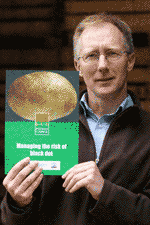Warm, wet soil makes back dot a danger

Expect 2008 to be a bad black dot year, Jeff Peters of CSL warned at last week’s East Anglian Potato Event.
Black dot is a disease favoured by warm, wet soil conditions,” he said. “High summer rainfall, such as we had throughout August, will increase the disease, especially where susceptible varieties are being grown.”
Principally a storage problem, black dot can be kept at intake levels by reducing crop temperature as quickly as possible after harvest. “Provided skins have set adequately, aim for a 0.5C pull-down a day to the desired holding temperature.
“You need to make sure that you have adequate ventilation during pull down, to remove surface moisture.”
Where a curing period was required, the problem would get worse, warned Dr Peters. “The trick is to reduce disease levels at intake and then keep them at manageable levels.”
 |
|---|
| The Potato Council’s guide to managing black dot will provide advice, Jeff Peters says. |
There was a good relationship between crop duration and disease, he added. “Black dot levels tend to be lower where a crop has been harvested early. But the date of harvest is less important than the length of time a crop is in the ground.”
This allowed growers to determine a black dot danger zone, he said. “For a maincrop variety, that’s about 130-135 days. For second earlies, it’s slightly less at 115 days. The work is continuing to find the same information for early varieties.”
As black dot could be both seed and soil-borne, an integrated approach was needed to manage disease risk, added Dr Peters.
“There’s now a commercial test available from SAC which allows you to detect for soil-borne inoculum. This is very valuable on rented land with an unknown history.”
The test measures the level of soil inoculum and gives a risk rating. Levels of less than 10 units DNA/g soil are considered low risk, between 10-100 units DNA/g soil is rated as medium risk and levels above 100 units DNA/g soil are high risk. “So you can get an indication of the likelihood of the disease developing.”

